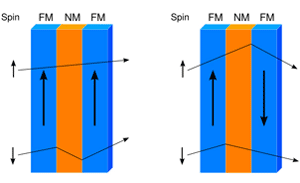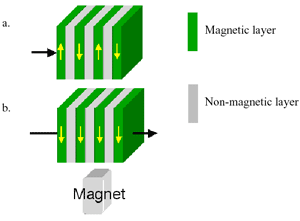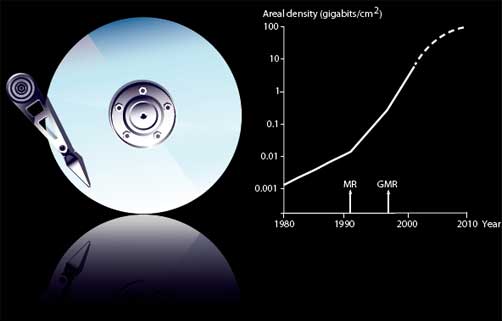Giant Magnetoresistance
According to Moore's Law, the number of transistors on a CPU chip is expected to continue to double every 18 months. The less-well-known counterpart in computer hard drive design, Kryder's Law, predicts exponential growth in hard drive memory, which increased by a factor of a thousand between 1998 and 2005 and fueled the recent advances that brought us the MP3 player and HDTV-on-demand. The physicists whose fundamental research made these devices possible, Albert Fert and Peter Gruenberg, won the Nobel Prize in physics in 2007 for their discovery of giant magnetoresistance (GMR), the large change in the resistance of a material produced by an external magnetic field.
About 150 years ago, the British physicist Lord Kelvin discovered that iron and nickel exhibit a small increase in electrical resistance along the direction of an applied magnetic field and a similar decrease in resistance in the transverse direction. This effect, called anisotropic magnetoresistance (AMR), led to a generation of hard drives in the 1990s, but with little improvement in the strength of the AMR effect since the days of Lord Kelvin. In the 1980s, most technologists dismissed the possibility of significant improvements in magnetoresistive sensing (see “The Discovery of Giant Magnetoresistance” in the Links section).
Two key advances by Fert and Gruenberg underpinned their discovery of GMR: spin-dependent scattering and exchange coupling. As explained by quantum mechanics, electrons, although they are point particles, act as if they are spinning--they possess intrinsic angular momentum, with units of plus or minus one half h/2π, where h is Planck’s constant. Electrons act like tiny magnets. In spin-dependent scattering, the way an electron interacts with a ferromagnetic material (a permanent magnet) depends upon the relative orientation of the electron’s spin and the magnetic field inside the ferromagnet.
Imagine a current of electrons inside a ferromagnet--their velocities point in all different directions, but the average electron velocity points in the direction of the current. If an electron is scattered, it will change direction, so the effect of scattering is to reduce the current, or, equivalently, to increase the material's electrical resistance.

This drawing shows a spin valve with two ferromagnetic (FM) layers separated by a nonmagnetic (NM) layer; when the magnetic fields in the two ferromagnetic layers are aligned, as shown in the diagram on the left, half the electrons experience relatively little scattering, leading to a substantial reduction in resistance. (Wikimedia Commons/Guillom)

In the upper diagram, the "interlayer exchange coupling" aligns the magnetization of the ferromagnetic layers in opposing directions in the absence of an applied external field. In the lower diagram, an external field overcomes the exchange coupling and aligns the magnetizations in the two layers. (Image credit: Materials Research Science and Engineering Center on Nanostructured Interfaces at the University of Wisconsin-Madison)
The other key advance was Gruenberg’s discovery of “interlayer exchange coupling.” Both he and Fert worked with extremely thin ferromagnetic layers, only nanometers thick. By separating two ferromagnetic layers with a thin nonmagnetic layer, Gruenberg observed that with no applied magnetic field, the magnetic fields in the two layers were opposite. (Louis Neel had seen the same effect in a different material in 1964.) And when Gruenberg applied an external magnetic field, the magnetic fields in both layers lined up, so the external field could control the relative directions of the internal magnetic fields (see drawing).
Working independently, Fert and Gruenberg combined spin-dependent scattering and interlayer exchange coupling to produce giant magnetoresistance--an electrical resistance with a substantial dependence upon the applied magnetic field. The drawing shows two ferromagnetic layers separated by a nonmagnetic layer.
- Above, the externally applied field lines up the magnetic fields in the two layers. The electrons oriented parallel to this field scatter far less than those oriented anti-parallel to it, reducing the electrical resistance for these electrons.
- Below, there is no applied field, so the magnetic fields in the two layers point in opposite directions (due to the interlayer exchange coupling). Half the electrons are spin-up and half are spin-down, and each interacts with a parallel and an antiparallel field, so the spin-up and spin-down electrons scatter in the same way.
This device is called a "spin valve.
Research
Leading up to the discovery of GMR, Fert had investigated magnetoresistance in multiple layers of iron and chromium, up to 60 layers of each. He conducted his experiments at liquid helium temperatures, about 4° above absolute zero. He observed a 50% change in resistance as he switched the magnetic fields from alternating to pointing in the same direction. Gruenberg, on the other hand, worked with trilayers-- iron/chromium/iron--at room temperature, and observed about a 1.5% change in resistance. He immediately recognized the technological possibilities in this discovery and obtained broad patents for GMR-based read heads.
IBM recognized the technological possibilities too, even though the methods the way Fert and Gruenberg produced their thin films require elaborate equipment unsuited to mass production. An IBM group led by Stuart Parkin produced the films by dislodging atoms from a target with a powerful atomic beam and depositing these atoms on a substrate, a process called sputtering. Although the resulting films were less uniform than those of Fert and Gruenberg, the process took place at room temperature and was much easier to carry out. With these films, Parkin's group produced a large enough effect at room temperature to make a much-improved read head, and discovered more fundamental GMR physics along the way.
The GMR read head "flys" over the hard disk and senses the magnetic field made by an array of tiny magnetic domains arranged in a circular pattern. The domains can have only two orientations, corresponding to a logical zero or one, and each produces a distinctive pattern of current in the read head. Because the GMR effect is so much stronger than AMR, the domains can be smaller and much more information can be packed onto the disk.

GMR-based hard drive, with graph showing exponential increase in hard disk storage density (photo and graph © The Royal Swedish Academy of Sciences 2007)
Within nine years of the discovery of GMR, IBM brought the first GMR-based read heads to market, making possible the multigigabyte hard drive. By 1999, the GMR-based read head was used throughout the computer industry, and it helped miniaturize the wildly successful iPod®. But technology moved on--in 2006 a different kind of read head appeared, based on a similar quantum mechanical phenomenon, tunneling magnetoresistance.
GMR ignited a whole new subfield of condensed matter physics—spintronics, the control of electron transport based on electron spin. A spintronics-based computer would store information in the spins of electrons rather in charges or voltages and process information through interaction among the oriented spins and magnetic domains. Bunches of oriented electrons already have been shown to preserve their orientation as they move through a wire over short distances, and this effect could become the basis of future computer processing (See BBC article in Links).
Three phases are anticipated for spintronics:
- Unpolarized currents interacting with magnetic materials--that's where we are today, with GMR.
- Spin polarized current flow in semiconductors--that would enable logic, memory, and communications, all on the same chip.
- Manipulation of individual spins--the orientation of an electron’s spin would carry information, leading to quantum computing.
As microprocessors become smaller and smaller, and their components closer and closer together, fabrication and heat dissipation become more difficult, threatening the continued progress described by Moore's Law. Spintronics may help solve these problems.
Links
The Royal Swedish Academy of Sciences
IBM
Scientific American
BBC














